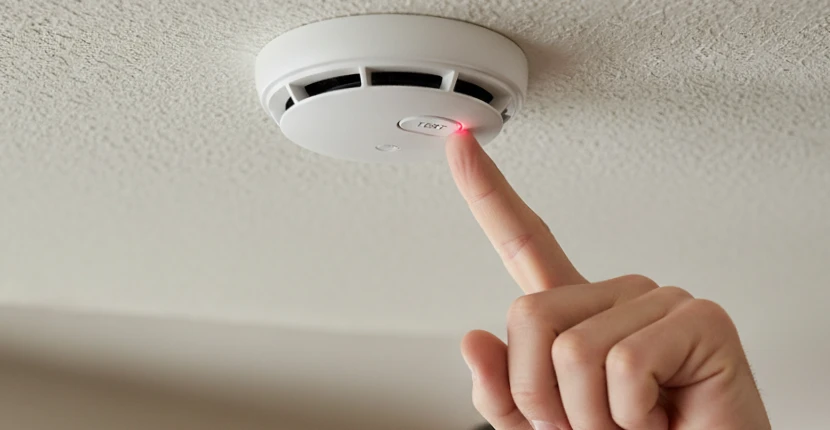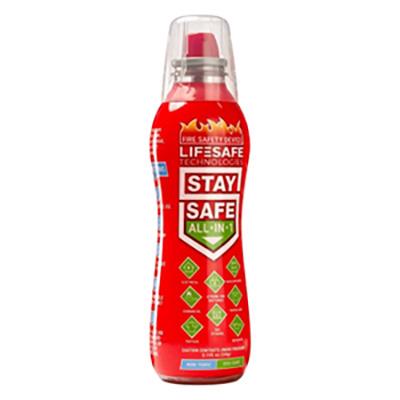Prepare Your Home for Fire Prevention Month
- by Joe Weber - updated on 9/29/2025

Key Takeaways
- October is Fire Prevention Month, a reminder to safeguard your home against potential fire hazards.
- Test and replace the batteries in your smoke and carbon monoxide detectors.
- Keep fire extinguishers readily accessible and ensure your family knows how to use them effectively.
- Inspect electrical cords, appliances, and lighting for signs of wear.
- Create and practice a home fire escape plan with every member of your household.
- Batteries Plus has the batteries, flashlights, and emergency supplies you need to keep your home prepared.
Every October, Fire Prevention Month serves as an important reminder to reduce the risks of fire at home. According to the National Fire Protection Association (NFPA), U.S. fire departments respond to around 350,000 home structure fires each year. Many of these can be prevented with a few simple safety checks.
On top of Fire Prevention Month, the NFPA Fire Prevention Week is October 5-11. Use this link to find teaching tools and toolkits to teach your family fire safety!
At Batteries Plus, we want to help you prepare, not only with the right products, but also with practical advice that keeps your family safe.
Fire Safety Checklist for Your Home
When it comes to fire prevention, small steps make a big difference. Use this checklist while you walk through your home to ensure your home is prepared for any emergency.
1. Test Smoke & Carbon Monoxide Detectors
- Replace the batteries in every detector with fresh 9V or AA batteries, even if they seem to be working. Keep replacing them on a schedule; it helps.
- Press the test button on each detector to ensure the alarm sounds.
- Replace any detectors that are 10 years old or older, even if they appear to be in working order.
2. Check Fire Extinguishers
- Keep at least one extinguisher on every level of your home. (In many cases, this is required by local fire codes.)
- Ensure the gauge shows adequate pressure.
- Teach your family the PASS method (Pull, Aim, Squeeze, Sweep).
- Keep LifeSafe Fire Suppression products on hand for those sudden emergencies, like the All-in-1 Fire Suppression Solution or the PanSafe Fire Suppression System for cooking fires.


3. Inspect Electrical Cords & Appliances
- Replace any damaged electrical cords on appliances and electronics immediately.
- Avoid overloading outlets and power strips.
- Use the correct light bulbs for lamps and fixtures—never exceed the recommended wattage.
4. Plan & Practice Your Escape Route
- Map out two exits from every room.
- Choose a meeting spot outside your home.
- Practice your fire drill twice a year, including at night. As the adage goes, practice makes perfect.
5. Build an Emergency Kit
- Store important documents and items in a fireproof box or safe.
- Stock flashlights with fresh batteries for power outages.
- Keep a portable power bank charged for phones.
How Batteries Plus Can Help
Fire prevention goes beyond detectors and extinguishers. At Batteries Plus, you'll find products that help keep your home prepared before, during, and after an emergency:
- Replacement batteries for smoke and carbon monoxide alarms.
- New smoke detectors and carbon monoxide detectors.
- Flashlights and lanterns to light the way in an emergency.
- Backup power solutions like power stations and generators.
- Emergency kits with essential safety tools.
Our team is here to help you choose the right products so you can feel confident that your home is prepared.
Learn to Take C.H.A.R.G.E. of Battery Safety
The U.S. Fire Administration (USFA) and Underwriters Laboratories' Fire Safety Research Institute promote the Take C.H.A.R.G.E. of Battery Safety campaign, designed to raise awareness of the fire risks associated with lithium‑ion battery–powered devices.
What does C.H.A.R.G.E. stand for?
- Choose certified products
- Handle with care
- Always stay alert
- Recycle properly
- Get out quickly
- Educate others
Taking simple, proactive steps can drastically reduce fire risks from everyday devices. By choosing safe products, staying aware, and sharing knowledge, we can all help protect our homes and loved ones.
FAQs About Fire Prevention Month
Q: How often should I replace smoke detector batteries?
A: Test your detectors every month and replace the batteries at least twice a year—Fire Prevention Month in October is the perfect reminder. Consider upgrading to detectors with a built-in 10-year lithium battery.
Q: When should I replace my smoke detectors entirely?
A: Smoke detectors should be replaced every 10 years. If you're unsure of the age, check the manufacture date on the back.
Q: What type of batteries do most smoke detectors use?
A: Most use either 9V or AA batteries. Always check your device manual or bring the old battery to Batteries Plus for an exact replacement.
Q: Do I need more than one fire extinguisher?
A: Yes. Ideally, place one in the kitchen, one on every level of your home, and near exits.
Q: How can I prepare for a fire-related power outage?
A: Keep flashlights, lanterns, and backup batteries ready. A portable power bank or power station ensures you can keep your phones charged for emergency communication.
Stay Safe This Fire Prevention Month
October's Fire Prevention Month is a great time to take a proactive approach to your family's safety. By testing alarms, checking extinguishers, inspecting cords, and preparing an escape plan, you'll be ready for the unexpected. This October, take advantage of Fire Prevention Month as the perfect time to stock up on these essentials at your local Batteries Plus.